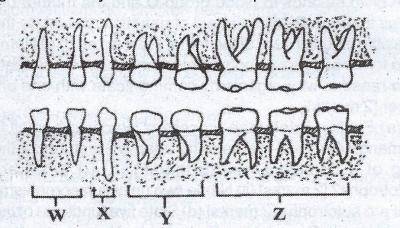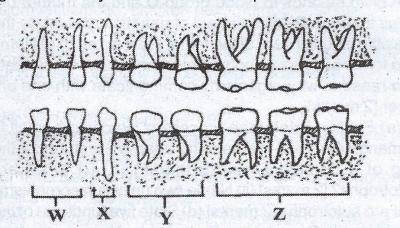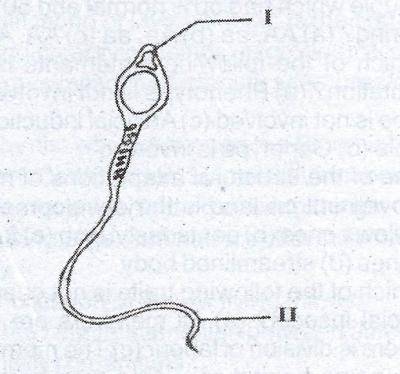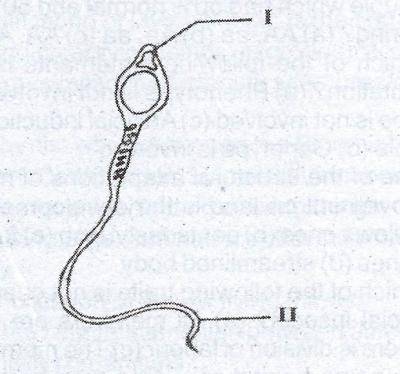Which of the following statements is not associated with pyramids of energy?
- A. Efficiency of energy transfer between trophic levels can be studied
- B. Comparisons of pyramids for different ecosystems can be made
- C. More accurate comparisons of trophic levels
- D. Representation of numbers of organisms at different trophic levels
Which of the following pyramids gives the most accurate picture of the relationships between at the various trophic levels in a food chain? A pyramid of
- A. numbers
- B. energy
- C. biomass
- D. size
Which of the following groups of organisms do not have members that can be called autotrophs?
- A. Protists
- B. Mosses
- C. Chlorophyta
- D. Fungi
Soil permeability refers to
- A. how easily water passes through the soil
- B. the proportion of air in the soil
- C. the proportion of water the soil holds
- D. how well water rises up the soil
Which of the following ecological factors will result in food shortage?
- A. Drought
- B. Low rate of reproduction
- C. Emigration
- D. Topography
The natural dwelling place of an organism is called its
- A. ecological niche
- B. habitat
- C. population
- D. environment
A population which exceeds its carrying capacity and then collapses is represented graphically by a
- A. bell-shaped curve
- B. linear curve
- C. sigmoid curve
- D. skewed curve
A good site for secondary succession would be
- A. a sand dune
- B. a bare rock
- C. a land that has just had forest fire
- D. a stretch of barren land
The number of individuals that the environment can support over a long period of time is its
- A. growth rate
- B. total capacity
- C. population capacity
- D. carrying capacity

The teeth which are absent in the young of the organism whose dentition is shown above is labelled
- A. W
- B. X
- C. Y
- D. Z

The diagrams below show the dentition of an organism. The function of the teeth labelled X is for
- A. biting and grasping
- B. chewing and grinding
- C. tearing and grasping
- D. chewing and tearing

The diagram above shows the dentition of an organism. What organism is this?
- A. rabbit
- B. cat
- C. frog
- D. man
Which of the following function is associated with calcium in plants? Formation of
- A. cell wall
- B. ribosomes
- C. proteins
- D. cell membrane
Which of the following processes are associated with photosynthesis? I. Energy from sunlight is absorbed II. Carbon dioxide is evolved III. Oxygen is given off IV. Glucose is synthesized
- A. I and II only
- B. I, II and IV only
- C. I, III and IV only
- D. I, II, III and IV
The complex energy-rich organic matter which living organisms need for life is
- A. water
- B. air
- C. food
- D. mineral salts
Which of the following types of placentation is not common amongst syncarpous pistils?
- A. Marginal
- B. Axile
- C. Parietal
- D. Free central

In the diagram of the human sperm above, the function of the part labelled II is to
- A. fuse the ovum during fertilization
- B. generate the energy for the sperm to swim to the fallopian tube
- C. help the sperm to swim forward
- D. dissolve the membrane of the egg during fertilization

The diagram above is an illustration of the human sperm. The part labelled I is the
- A. acrosome
- B. nucleus
- C. mitochondrion
- D. tail
When viewing an object that is close to the human eye, the
- A. eye lens becomes thin
- B. ciliary muscles relax
- C. suspensory lens become taut
- D. eye lens becomes fat
Which of the following sequences is the correct route of the transmission of impulses along a reflex arc?
- A. \(Receptor\to sensory neuron \to synapse \to intermediate neuron \to synapse \to motor neuron \to effector\)
- B. \(Receptor \to motor neuron \to synapse \to intermediate neuron \to synapse \to sensory neuron \to effector\)
- C. \(Effector \to intermediate neuron \to synapse \to motor neuron \to synapse \to sensory neuron \to receptor\)
- D. \(Effector \to motor neuron \to synapse \to sensory neuron \to synapse \to intermediate neuron \to receptor\)
Which of the following glands also serves as an exocrine gland?
- A. Ovary
- B. Pancreas
- C. Adrenal
- D. Thyroid


